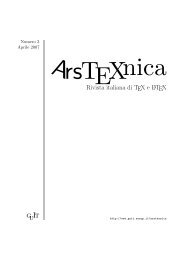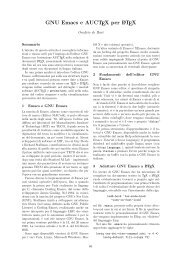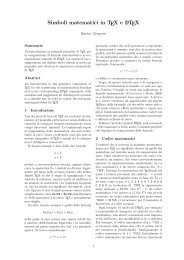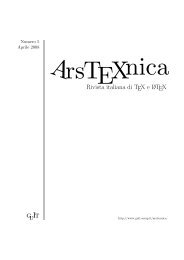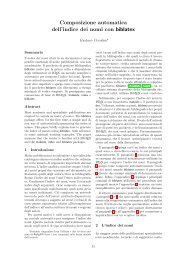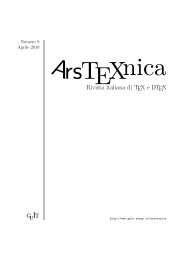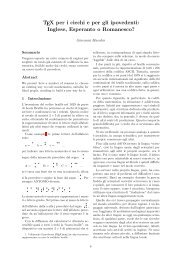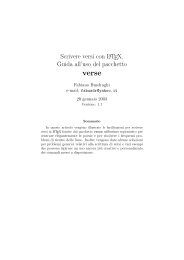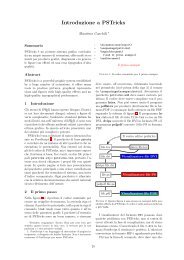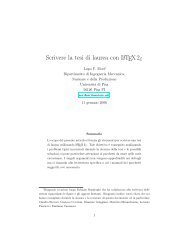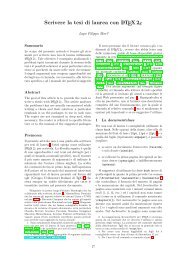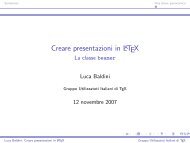ArsTeXnica, Numero 4, Ottobre 2007 - GuIT - Scuola Superiore Sant ...
ArsTeXnica, Numero 4, Ottobre 2007 - GuIT - Scuola Superiore Sant ...
ArsTeXnica, Numero 4, Ottobre 2007 - GuIT - Scuola Superiore Sant ...
You also want an ePaper? Increase the reach of your titles
YUMPU automatically turns print PDFs into web optimized ePapers that Google loves.
ArsT EXnica Nº 4, <strong>Ottobre</strong> <strong>2007</strong> Guidelines for Bibliographical Citations in LAT EX<br />
@BOOK{herbert-anderson2000,<br />
AUTHOR = {Brian Herbert and Kevin J.<br />
Anderson},<br />
TITLE = {House {Atreides}},<br />
PUBLISHER = {Bantam},<br />
SERIES = {Prelude to Dune},<br />
NUMBER = 1,<br />
YEAR = 2000,<br />
MONTH = feb}<br />
@BOOK{robeson1974b,<br />
AUTHOR = {Kenneth Robeson},<br />
TITLE = {The Crimson Serpent},<br />
PUBLISHER = {Bantam},<br />
SERIES = {Doc Savage Series},<br />
NUMBER = 78,<br />
YEAR = 1974,<br />
MONTH = oct}<br />
@BOOK{robeson1974c,<br />
AUTHOR = {Kenneth Robeson},<br />
TITLE = {The Devil Genghis},<br />
PUBLISHER = {Bantam},<br />
SERIES = {Doc Savage Series},<br />
NUMBER = 79,<br />
YEAR = 1974,<br />
MONTH = nov}<br />
Figure 1: Bibliography sample.<br />
• or they can acknowledge anterior or comparable<br />
works.<br />
In both cases, we require that references to citations<br />
are unambiguous, so looking for them within<br />
the ‘References’ section should be easy. Some examples<br />
could be:<br />
[3] is known as one of the best adventures<br />
of Doc Savage. [. . . ] Brian Herbert and<br />
Kevin J. Anderson continued the Dune<br />
saga [1].<br />
where a ‘plain’ 2 style is used, that is, references<br />
are labelled with numbers.<br />
The style of the first example is controversial:<br />
some people think that a text should remain intelligible<br />
if references to bibliographical citations are<br />
removed. A good rewriting of this sentence would<br />
be:<br />
The Devil Genghis [3] is known as one of<br />
the best adventures of Doc Savage.<br />
Let us remark that the title has been typed ‘manually’<br />
in this previous sentence. In fact, we can think<br />
that there is information redundancy between the<br />
title both typed and given in the ‘References’ section.<br />
If there is a mistake about this title, it must be<br />
fixed in several places: the bibliography database<br />
file and all the occurrences within the text’s body.<br />
2. According to BibT E X’s terminology.<br />
104<br />
The second example does not meet this criticism,<br />
that sentence makes sense even if the citation is<br />
removed, but let us rewrite it using a ‘long’ style,<br />
that is, references are labelled with authors’ names,<br />
followed by the publication’s year:<br />
Brian Herbert and Kevin J. Anderson<br />
continued the Dune saga [Herbert & Anderson<br />
2000].<br />
First, the same problem of information redundancy<br />
occurs, about the authors’ names. Second, the<br />
citation could omit them, since they are given<br />
earlier in the sentence:<br />
Brian Herbert and Kevin J. Anderson<br />
continued the Dune saga [2000].<br />
Now let us come to a short synthesis of the<br />
main citation schemes used throughout printed<br />
documents. As mentioned in (Butcher, 1992, § 10),<br />
there are four schemes:<br />
number-only publications are sequentially numbered<br />
in the ‘References’ section, and citations<br />
refer to these numbers;<br />
author-date 3 citations use authors’ names, followed<br />
by the publication’s year; if an author<br />
published several works in a year, that year<br />
is suffixed with lowercase letters (e.g., ‘1974a’,<br />
‘1974b’); in addition, references to citations<br />
can be abridged: only the year is given if<br />
the author’s name is known, and multiple<br />
citations concerning the same author supply<br />
this name only once (e.g., ‘[Robeson 1974a,<br />
1974b]’ rather than ‘[Robeson 1974a, Robeson<br />
1974b]’); more details about this scheme<br />
can be found in (Chicago, Ch. 16);<br />
author-number this system is similar to the<br />
author-date system, except that each author’s<br />
publications are numbered and citations use<br />
authors’ names, followed by this number, e.g.,<br />
‘[Robeson (2)]’;<br />
short-title references are given directly in the<br />
text at the first mention, the others may consist<br />
of an abridged form using the author’s<br />
name only, followed by an abbreviation of<br />
the title if there are several works of this author<br />
4 ; a full bibliography at the document’s<br />
end may sum up all the references, it can also<br />
be omitted, since a complete specification of<br />
each reference is provided either inside the<br />
text, or in footnotes 5 .<br />
3. Also known as ‘Harvard system’.<br />
4. From our personal point of view, ‘short-title’ is not<br />
good terminology for this system, because titles may be<br />
omitted for repeated references, if there is no ambiguity.<br />
In other words, the short-title system does not use titles<br />
always.<br />
5. This last style is most used within this scheme and<br />
often called ‘footnote-referencing’.




